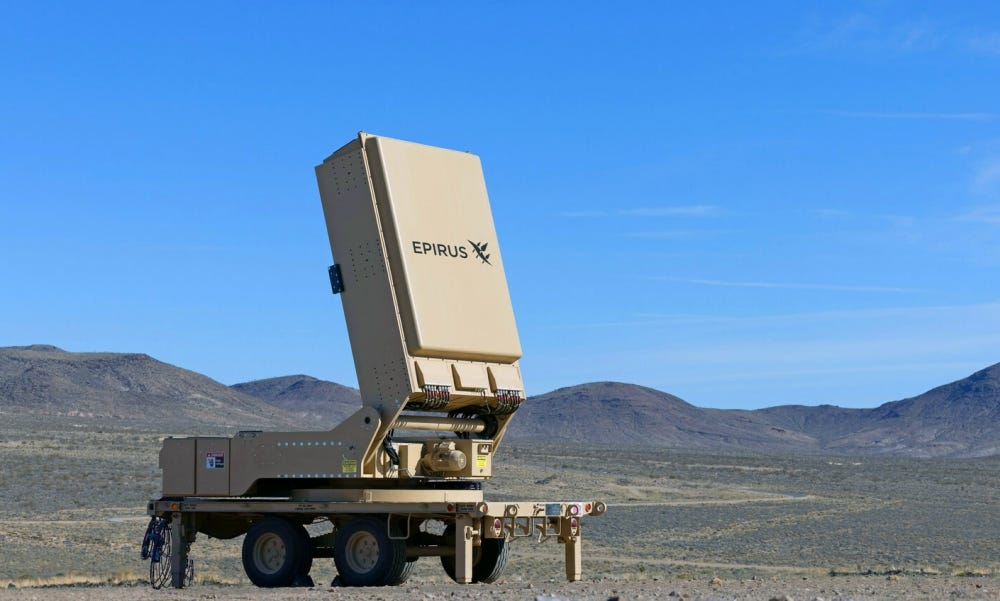Epirus Leonidas: The Future of Counter UAS Warfare (CUAS)
In this edition of The Engineer's Perspective. We look at Epirus' Leonidas System, a counter-unmanned aerial system (C-UAS) that leverages high-power microwave (HPM) technology to neutralize drones.
The Engineer's Perspective is a reader-supported publication. Sign and up and subscribe to see more in-depth Aerospace/Aeronautical Analysis!
Table of Contents:
Overview
Historical Development
Specifications
Concept of Operations
Systems Engineering Requirements
Calculations (Optional)
Implications and Future Considerations
Conclusion
References
Overview:
The Leonidas system, developed by Epirus, is a state-of-the-art counter-unmanned aerial system (C-UAS) that leverages high-power microwave (HPM) technology to effectively neutralize drones. As unmanned aerial vehicles (UAVs) proliferate and pose significant threats to military operations and critical infrastructure, Leonidas offers a timely and innovative solution.
Key features of the Leonidas system include:
Directed Energy Weapon: Utilizing non-kinetic high-power microwaves, Leonidas disables drones without physical projectiles.
Multi-Target Engagement: Capable of simultaneously engaging multiple threats, it is particularly effective against drone swarms.
Adaptable Platform: Its modular design allows for both static and mobile deployments, enhancing operational versatility.
Cost-Effective Solution: Operating at "pennies per kill," Leonidas provides an economical alternative to traditional kinetic systems.
Rapid Response: The system engages targets at the speed of light, crucial for time-sensitive scenarios.
Evolving Technology: With a software-defined architecture, it can be continuously updated to counter emerging threats.
The significance of Leonidas extends beyond military applications; it also plays a vital role in protecting civilian infrastructure and public events. As drone technology evolves, Leonidas exemplifies the shift towards flexible, precise, and cost-effective solutions in modern defense strategies. This newsletter will delve into its capabilities, historical development, and future implications within the context of contemporary security challenges.
Historical Development
Epirus was founded in 2018 in Los Angeles, California, with the specific goal of developing innovative solutions for the rapidly emerging counter-drone market. The company recognized the growing threat posed by small, inexpensive consumer drones that were becoming increasingly difficult to counter using traditional kinetic defense systems.
Key milestones in Epirus' history include:
2018: Company founded, focusing on developing solid-state, software-defined directed energy systems.
2019: Epirus began engaging with the aerospace industry and the U.S. Air Force, winning innovation research contracts to refine their counter-drone technology.
2020:
The original Leonidas system was unveiled, marking Epirus' entry into the counter-UAS market with high-power microwave (HPM) technology.
Epirus entered into a supplier agreement with Northrop Grumman to provide Electromagnetic Pulse (EMP) capability for counter-UAS solutions.
2021:
Leonidas demonstrated impressive capabilities, successfully neutralizing 66 out of 66 drone targets in a U.S. government demonstration.
The company raised $70 million in Series B funding to advance its directed energy technology.
Epirus expanded its advisory board, adding notable figures from the defense sector.
February 2022:
Epirus introduced the Leonidas Pod, a portable version of their HPM system, expanding their product portfolio.
The company raised $200 million in Series C funding, highlighting strong investor confidence.
April 2022: Epirus launched the third-generation variant of Leonidas, featuring significantly enhanced power output and capabilities.
October 2022: In collaboration with General Dynamics Land Systems, Epirus unveiled the Stryker Leonidas, an integrated counter-electronics system mounted on a Stryker vehicle.
January 2023: Epirus secured a $66.1 million contract from the U.S. Army for the Leonidas system as part of the Indirect Fire Protection Capability-High-Power Microwave Program.
September 2024: The company introduced the Leonidas Expeditionary version, further expanding the system's versatility and deployment options.
Throughout its history, Epirus has maintained a rapid pace of innovation, continuously improving its technology to address evolving threats. The company has also focused on building strong relationships within the defense industry and with government agencies, positioning itself as a key player in the counter-UAS and directed energy fields.
Keep reading with a 7-day free trial
Subscribe to The Engineer's Perspective to keep reading this post and get 7 days of free access to the full post archives.


